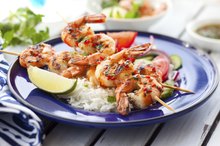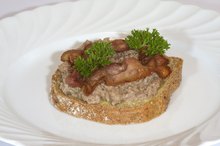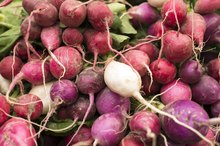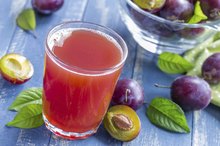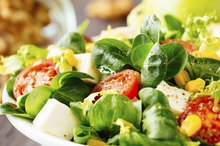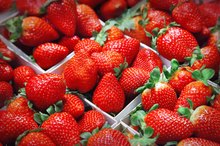Gluten-Free Gout Diet
You must plan your meals carefully if you have gout and celiac disease or gluten sensitivity so that you adhere to the guidelines of both diets. On a gout diet, the goal is to avoid high purine foods because they increase uric acid production. While following a gluten-free diet you avoid foods containing wheat, rye and barley. Because many foods low in purines contain gluten, you'll need to make some adjustments to your meal planning so that you choose nutritious foods that are both gluten-free and low-to-moderate in purines.
Avoiding Gluten
Wheat, rye and barley are major crops in the United States and, as so, are found in a large variety of foods, making avoidance challenging, but not impossible. What's more, breads and cereals are often recommended on a gout diet because they are low in purines. Check food labels to avoid gluten, and avoid foods made from wheat, rye and barley. Grains are used in the processing of ingredients that may not stand out as containing gluten. The following ingredients may contain gluten: hydrolyzed vegetable protein, malt, malt flavoring, cereal products, modified starch and vegetable gum. Obtaining a full list of gluten-free foods can help you with meal planning.
- Wheat, rye and barley are major crops in the United States and, as so, are found in a large variety of foods, making avoidance challenging, but not impossible.
- What's more, breads and cereals are often recommended on a gout diet because they are low in purines.
Avoiding High Purine Foods
Gout and Shrimp
Learn More
The typical diet contains anywhere from 600 to 1,000 milligrams of purines on average. On a purine-restricted diet you aim to stay within the target your doctor sets for you. The typical low-purine diet restricts you to 100 to 150 milligrams per day. Purines are found in many foods, but are particularly rich in organ meats, game meats, anchovies, meat extracts, sardines, scallops, mussels, mackerel, gravies, broths, haddock, herring, shrimp, yeast and yeast extract. Even though these foods are gluten-free, you need to avoid them when following a gout diet.
- The typical diet contains anywhere from 600 to 1,000 milligrams of purines on average.
- Even though these foods are gluten-free, you need to avoid them when following a gout diet.
Meal Planning
On a gluten-free gout diet, you can build your meals and snacks around a variety of vegetables, fruit, low-fat dairy, nuts, seeds, healthy fats, eggs, lean meat and fish, except for fish listed as high in purines. Red meat, poultry, asparagus, cauliflower, mushrooms, spinach, fish and legumes are moderate in purines, so your doctor may provide a recommended limit of servings per day. The University of Pennsylvania Medical Center recommends limiting meat to 3 ounces per meal and 6 ounces daily 1.
Sample Menu
Foods That May Cause Joint Pain
Learn More
Fruit with low-fat yogurt and an egg is an example of a good breakfast on a gluten-free gout diet. For lunch you can have rice pasta with tomato sauce and 3 ounces of turkey. When choosing pasta, opt for pasta made from potato, egg, rice, quinoa or another gluten-free source. For dinner you can have 3 ounces of skinless chicken breast, a small baked potato and 1/2 cup of zucchini. Because nutritional needs are highly individual, follow your doctor's recommendations.
- Fruit with low-fat yogurt and an egg is an example of a good breakfast on a gluten-free gout diet.
- For dinner you can have 3 ounces of skinless chicken breast, a small baked potato and 1/2 cup of zucchini.
Related Articles
References
- University of Pennsylvania Medical Center: Low-Purine Diet
- Jackson Siegelbaum Gastroenterology: Gluten-Free Diet
- Myrtue Medical Center: Low-Purine Diet -- Gout Diet Treatment
- National Institute of Arthritis and Musculoskeletal and Skin Diseases. Gout. Updated April 2016.
- Zhang Y, Chen C, Choi H, et al. Purine-rich foods intake and recurrent gout attacks. Ann Rheum Dis. 2012; 71(9):1448-53. doi:10.1136/annrheumdis-2011-201215
- Fischer E. Ueber die Harnsauer. 1 [On Uric Acid. 1]. Berichte der Deutschen Chemischen Gesellschaft. 1884: 17:328-338. doi:10.1002/cber.18980310304
- Ragab, G., Elshahaly, M., & Bardin, T. (2017). Gout: An old disease in new perspective – A review. Journal of Advanced Research, 8(5), 495–511. doi:10.1016/j.jare.2017.04.008
- Centers for Disease Control and Prevention. Gout. Updated January 28, 2019.
- Zgaga, L., Theodoratou, E., Kyle, J., Farrington, S. M., Agakov, F., Tenesa, A., … Campbell, H. (2012). The Association of Dietary Intake of Purine-Rich Vegetables, Sugar-Sweetened Beverages and Dairy with Plasma Urate, in a Cross-Sectional Study. PLoS ONE, 7(6), e38123. doi:10.1371/journal.pone.0038123
- Choi HK, Gao X, Curhan G. Vitamin C intake and the risk of gout in men: a prospective study. Arch Intern Med. 2009;169(5):502–507. doi:10.1001/archinternmed.2008.606
- Zhang Y, Neogi T, Chen C, Chaisson C, Hunter DJ, Choi HK. Cherry consumption and decreased risk of recurrent gout attacks. Arthritis Rheum. 2012;64(12):4004–4011. doi:10.1002/art.34677
- Arthritis Foundation. Gout Diet: Dos and Don’ts.
- Boban M, Modun D. Uric acid and antioxidant effects of wine. Croat Med J. 2010;51(1):16–22. doi:10.3325/cmj.2010.51.16
- Caliceti C, Calabria D, Roda A, Cicero AFG. Fructose Intake, Serum Uric Acid, and Cardiometabolic Disorders: A Critical Review. Nutrients. 2017;9(4):395. Published 2017 Apr 18. doi:10.3390/nu9040395
- U.S. Department of Health and Human Services and U.S. Department of Agriculture. 2015–2020 Dietary Guidelines for Americans. 8th Edition. Published December 2015.
- U.S. Department of Health and Human Services. Gripped by Gout. NIH News in Health. Published February 2014.
- Kakutani-Hatayama M, Kadoya M, Okazaki H, et al. Nonpharmacological Management of Gout and Hyperuricemia: Hints for Better Lifestyle. Am J Lifestyle Med. 2015;11(4):321–329. Published 2015 Sep 2. doi:10.1177/1559827615601973
Writer Bio
Janet Renee is a clinical dietitian with a special interest in weight management, sports dietetics, medical nutrition therapy and diet trends. She earned her Master of Science in nutrition from the University of Chicago and has contributed to health and wellness magazines, including Prevention, Self, Shape and Cooking Light.
